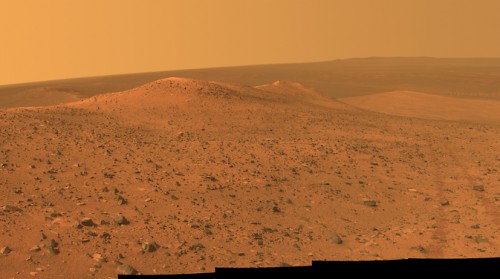"Dubiak's ridge sticks out like a bone in the throat. "We want to understand why it is located outside the rim of Endeavor Crater and how it fits into the geological story of this area," said Jim Rice, of the Planetary Science Institute in Tucson, Arizona.

The most recent fieldwork of the Opportunity robotic vehicle, which has been exploring a series of craters on Mars since 2004, deals with the slope of a prominent hill, jutting out from the rim of a large crater and a small crater adjacent to it. The site is called Wdowiak Ridge.
"Dubiak's ridge sticks out like a bone in the throat. We want to understand why it is located outside the rim of Endeavor Crater and how it fits into the geologic story of that region," said Jim Rice, of the Planetary Science Institute in Towson, Arizona, and a member of Opportunity's science team.
The ridge covers an area of 150 m, is about 12 meters above the surface, and is about two football fields away from the main ridge line of the western rim of Endeavor Crater. The team named this hill "Dubiak Ridge" as a tribute to Opportunity crew member Thomas Dubiak (1939-2013), who taught astronomy for decades at the University of Alabama at Birmingham.
"Tom would have enjoyed that look," said Rice, who first knew Thomas Dubiak as an avid space expert who appeared on local Alabama television in the XNUMXs, when Rice was in elementary school. "Ten years later, when NASA selected me to join the Mars rover science team, I told Tom that he was my inspiration," Rice added. "One of the most important things for us in this mission is encouraging young people to be interested in space exploration."
Opportunity approached the Dubiac hub from the north after traveling along the western rim of Endeavor Crater, which is 22 kilometers in diameter. The vehicle is currently examining rocks that were thrown out as a result of a meteorite that dug a crater about 30 meters wide at the southern end of the ridge known as Ulysses."
"Ulysses is like a punch inside the Dubiak Ridge. The rock field around the crater gives us examples of different types of rocks from within the ridge," said Steve Squires of Cornell University, the principal investigator of the Opportunity Project. "Dubiak Ridge is the route with the most dramatic topographical features we have seen on this mission. Why is he standing like that? Is it particularly resistant to abrasion? What made him?”
For information on the NASA website
In the same topic on the science website:

One response
The image is 'a little' bigger (full size)
http://www.nasa.gov/sites/default/files/thumbnails/image/pia18614-main_sol3786b_l257atc.jpg